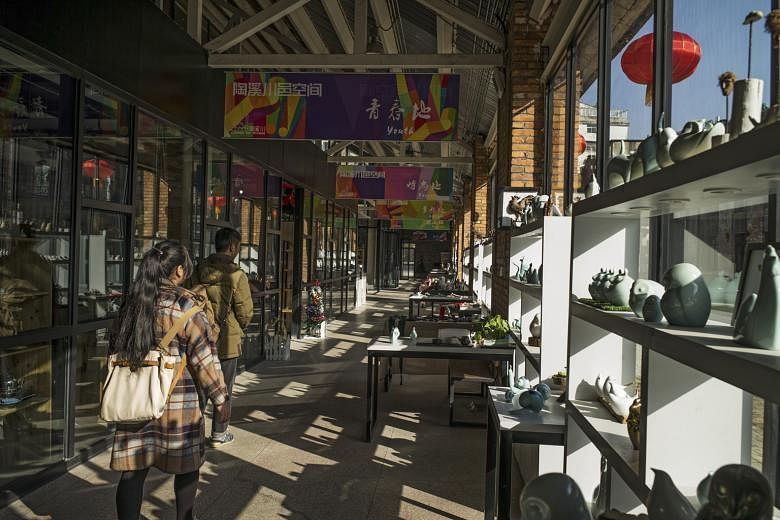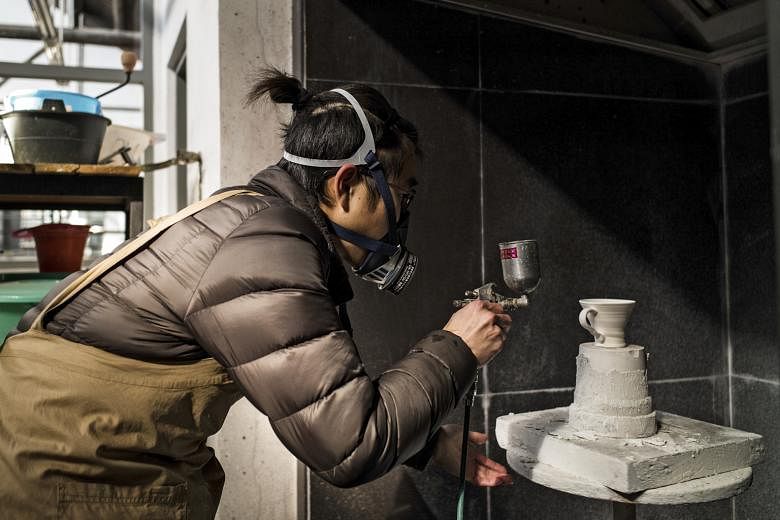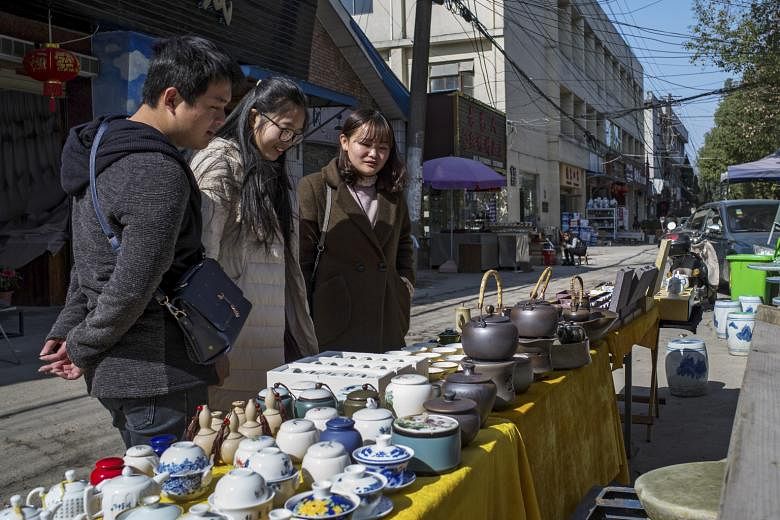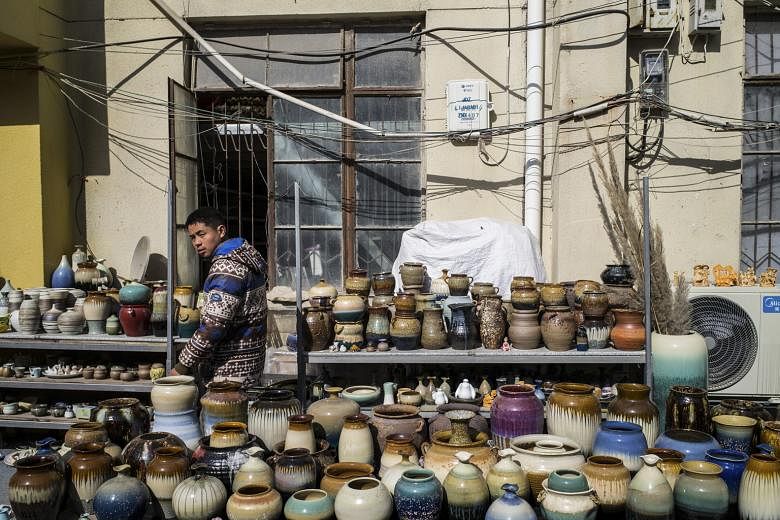JINGDEZHEN (Jiangxi) • For centuries, the most coveted china from China came out of Jingdezhen's workshops - fashioned from clay made smooth by trained hands, fired in kilns and then conveyed around the world.
The works graced the courts of the Persians, Mongols and French. Some craved blue-and-white vases. Others admired jade-green celadon bowls. The porcelain was China's greatest export, the rival of silk.
The fall of the Qing dynasty and war and revolutions in the 20th century broke the artisan culture, unless one counts communist statues as an important stage in China's hallowed porcelain tradition.
Now, that tradition is being revived at the roots. Young people are moving to study in Jingdezhen, a river town in the southern province of Jiangxi. Studios and workshops have popped up around town and in surrounding valleys. Some of the new artisans hope to profit from their skills, since China's middle-class boom in recent decades has boosted demand for porcelain.
"I like the atmosphere here very much," said Ms Fang Xin, 27, who hails from the Guangxi region, as she showed me how she was sculpting a clay cup with her hands one morning at a former factory.
"A lot of people with dreams come here," she said. "There is a wide variety of teachers, and they teach all kinds of skills and ideas."
There is even a term for young artists like Ms Fang: jingpiao, or Jingdezhen drifters.
She was working in a space managed by the Pottery Workshop, an education centre opened in 2005 by sculptors Caroline Cheng and Takeshi Yasuda that has become a magnet for jingpiao. (The workshop's mother branch opened in Hong Kong in 1985.) The centre has been critical in rejuvenating the Jingdezhen ceramics scene.
In 2008, Ms Cheng opened a Saturday outdoor market in a courtyard space beside the workshop and its cafe, so artists could try to make a living by selling their creations.
The idea came when a recent workshop graduate asked Ms Cheng if she could sell items outside the cafe. She wanted to set up on a blanket, but Ms Cheng insisted on erecting a proper tent covering, said Mr Liu Po Wen, the workshop's deputy director and a teacher there. These days, about 80 artists take part in the market. They place their wares on tables under white awnings.
Mr Liu is from Taiwan and studied ceramics art there and in the United States before teaching at the University of North Carolina at Greensboro. He joined the Pottery Workshop in December 2015 after answering an ad for a teaching position. His wife, son and daughter continue to live in Greensboro.
"Since I was a student, I've wanted to come to Jingdezhen," he said. "It's the mecca."
He teaches students in groups of about 15, in a building at the rear of the compound, which is on the grounds of a state-run sculpture factory. Two brick chimneys from an unused kiln rise near the education centre. Many students are recent graduates of the Jingdezhen Ceramic Institute, the most prominent academy in town.
"Their craftsmanship is amazing and the technical level is very high," said Mr Liu. "But their conceptual skills need improvement. There's too much historical burden. They need to break out of the boundaries.
"If I ask them to make a cup, say, they will make something very uniform," he added. "They might have an idea of what a Chinese cup looked like 1,000 years ago. They will stick with this. I personally like more creativity. I tell them to have the work reflect handmade quality, not something made by machine."
Although most of the students are Chinese, the workshop has an international flavour. At any given time, it has about eight artists in residence, most of them from outside China. They stay up to six months.
There are also foreign study groups. In the cafe, I met Mr Brandon Schnur, 29, the co-leader of a group of 13 students from the West Virginia University Ceramics Programme who were visiting for the summer.
The workshop has a pottery kiln that resident artists can use. They work in individual studios on the upper floor of one building. Sunlight streams in from large glass windows.
Canadian Denise White, 29, was working on a painting on porcelain - a small outdoor scene with snow-covered trees and a polar bear. She said her goal for the 21/2-week residency was to design moulds of Canadian scenes that she could take home to make sculptures for sale.
"I got 13 small moulds made here," she said. "The master mould-makers here can pretty much do anything."
Jingdezhen has been producing ceramics since the early dynastic times. But it was during the Tang dynasty, from 618 to 907, that word of the town's arts spread.
In that era, Jingdezhen was called Changnan because it sits on the south bank of the Chang River, and some historians say the term "china" - and thus the Western name of the country - came from a bad transliteration of the town's name. Some scholars date China's earliest fine porcelain to the Five Dynasties and 10 Kingdoms period, a time of upheaval in the 10th century.
Dynasties rose and fell, but each new emperor ordered porcelain to be taken from Jingdezhen to the court. Imperial officials were posted in Jingdezhen to oversee production. Pieces from here carried a stamp of authenticity and gained prominence worldwide.
Today, such works are among the most highly valued in the Chinese art world. At a 2014 Sotheby's auction in Hong Kong, Shanghai businessman Liu Yiqian offered a record-setting US$36.3 million (S$51 million) for a delicate Ming dynasty porcelain cup called a "chicken cup" that had been fired in Jingdezhen's imperial kilns.
After paying for the cup with a credit card, he took a celebratory sip of tea from it.
After the Communists took power in 1949, Jingdezhen became known for the production of propaganda statues. By 1958, that work had been consolidated into 10 main factories or studios.
In recent years, the local government has begun its own efforts to rejuvenate the porcelain industry. But people in the industry say it is the small, privately run workshops that are revitalising the traditions while injecting them with new ideas.
One such workshop lies in the Sanbao Village area across a river. Artists and business people have opened workshops and studios throughout the lush valley.
Perhaps the most striking is Zhenrutang, whose sprawling showroom consists of four connected traditional homes transported from the white-walled village area of Huizhou, in neighbouring Anhui province. Bowls, plates and vases set atop tables are bathed in a soft glow from overhead lights. Buddhist figurines are also on display.
The porcelain works are designed by Mr Jiang Bo, 35, a native of Xi'an who came to Jingdezhen in 2001 to study at the ceramics institute. Eight years later, he opened his own studio. Now, more than 40 people work there.
One signature piece is a small teapot with a pair of cups, all in a creamy powder blue. Each cup has a tiny rough nub on the otherwise smooth bottom, like a rock protruding from an ocean's surface. Called Mountain And Water, the set sells for US$150.
"If you want to develop a career around ceramics, Jingdezhen is the best place," said Mr Jiang, now the firm's vice-general manager.
Like the Pottery Workshop, Zhenrutang has a residency programme for foreign artists.
"More and more young people have decided to stay here," said Mr Jiang. "Some of them come from big cities. Here, it's easier to start ceramics workshops."
Still, like the town's pottery, some Jingdezhen drifters are now moving to other corners of China. Ms Cheng said artists were getting married, having children and asking themselves what environments were more suitable. She lives in Dali, a rural town in Yunnan province that has attracted an extraordinary number of Chinese fleeing the cities.
"I have now met a lot of people who have gone home," she said. "I really don't encourage people to stay in Jingdezhen forever. It's good that they go home. They can teach others what they've learnt here."
NYTIMES
•Vanessa Piao contributed research from Beijing.




